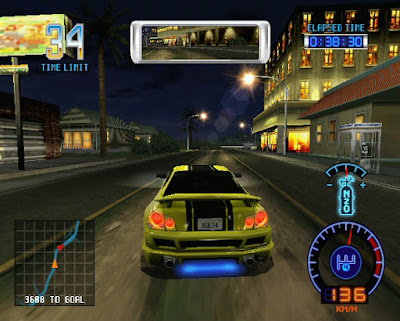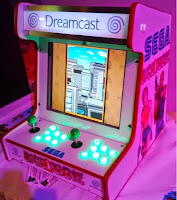Alongside the recently covered Maximum Speed, Sammy's 2004 street racing title Faster Than Speed represents one of only two racing titles released for the Atomiswave arcade platform. Faster Than Speed differs from its stablemate in that it is a street racing title with an emphasis on high stakes, blink-and-you'll-miss-it, one-on-one vehicular duels through neon soaked city streets; in stark contrast to Maximum Speed's more traditional, reality-based stock car racing shenanigans.
Now, while it's quite clear that Sammy plundered Sega's own back catalogue when searching for inspiration for Maximum Speed (it doesn't require a PhD in the field of 'looking at stuff' to see the similarities between Maximum Speed and Daytona USA), the inspiration for Faster Than Speed is - checks notes - unequivocally Electronic Arts' phenomenally successful 2003 underground street racing title Need for Speed: Underground. A game that was released a year earlier than Faster Than Speed and which also offers high stakes, winner-takes-all races in highly tuned import vehicles, through perpetually dark (but beautifully lit) city streets, parks, boardwalks and other civic areas not really designed to be driven through at 100mph.
It's true that other night-themed racers existed in this period (Midnight Club springs to mind), and there were some small, independent art house movies that also touched on the topic at the time, but for me there is no other title that is as heavily borrowed from than Need for Speed: Underground when it comes to the aesthetic or the general demeanour that Faster Than Speed is trying to exude. Hell, even the name is a sort of side-eyed reference to EA's title - they may have the need for speed, but we're faster than speed!
It's a subtle touch (almost as subtle as Bizarre Creations naming its flagship Xbox racing series after Gotham City in reference to Metropolis being cited in the title of its Dreamcast prequel); yet it is enough to corroborate my suspicions that yes, Faster Than Speed was plopped out by Sammy to cash in on the massive popularity of Need for Speed: Underground. And those small movies about cars that nobody saw. Cough.
Naming and visual conventions aside though, there's precious little else within the Faster Than Speed package that compares favourably to Need for Speed: Underground. That's because, well, Faster Than Speed is (whisper it) a bit naff. Before anyone leaps down my throat I want to qualify that the work done by such amazingly talented people as megavolt85 et al over at Dreamcast-Talk is the reason that Atomiswave games are now able to be played on the Dreamcast console.
The Atomiswave is about as esoteric and rare as forgotten arcade platforms get, and due to that fact, the vast (vast) majority of people will have either never heard of the system; and even fewer outside of either the arcade collecting scene or - more recently - the Dreamcast scene will have ever had the opportunity to play many of the exclusive titles. Faster Than Speed is one such Atomiswave exclusive and that we now have the ability to sample these uncommon titles is a testament to the devotion of the Dreamcast community in bringing such long-lost games back to the fore. Even in light of the impressive resurrection of the Atomiswave library though, we mustn't turn a blind eye to mediocrity...which unfortunately is exactly where Faster Than Speed conks out.
As stated, Faster Than Speed was released in arcades in 2004. There appear to be two variants of the cabinet made available - both of which seem to be quite rare, according to the user ratings over at the International Arcade Museum. The first is an upright arcade cabinet with a steering wheel, pedals and the kind of bench seat that looks like it would cause irreparable damage to your arse after too long sitting on it; while the other is a sit-down model with a proper racing bucket seat (see the flyer below for details).
An intriguing sidenote about this system though, is that the documentation (available on an archived snapshot of the Sega Amusements website) makes reference to several update kits, whereby arcade operators could install Faster Than Speed Atomiswave hardware, buttons and marquees in cabinets that previously housed such iconic racers as Rush: The Rock, Cruisn' USA, and even Ridge Racer (the upright cab, not Ridge Racer Full Scale).
 |
| The rear of the Faster Than Speed flyer (Image credit: Sega Amusements) |
Taking even a cursory glance at the promotional materials for Faster Than Speed, it's quite evident that Sammy was positioning the game as a multiplayer-first experience; the operation manual explains how to go about activating the hidden 'Head 2 Head' mode, whereby two cabinets must be linked together via the optional router and then the Head 2 Head mode be switched on in the Atomiswave system menu. By default, this option is set to off. So what option is there for the arcade proprietor who only owns a singular cabinet? Four player alternate mode, of course!

















































